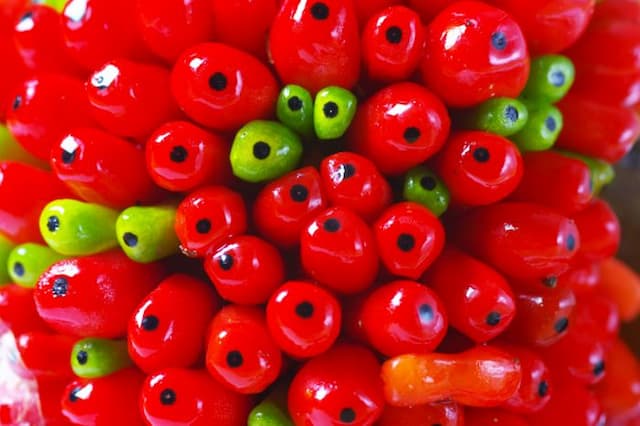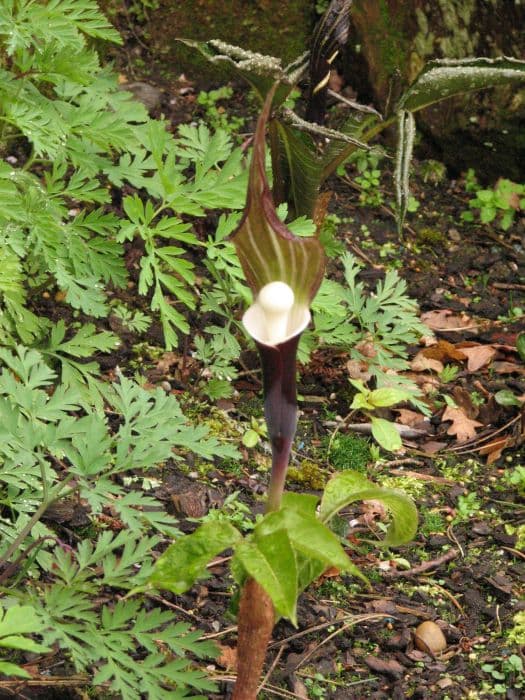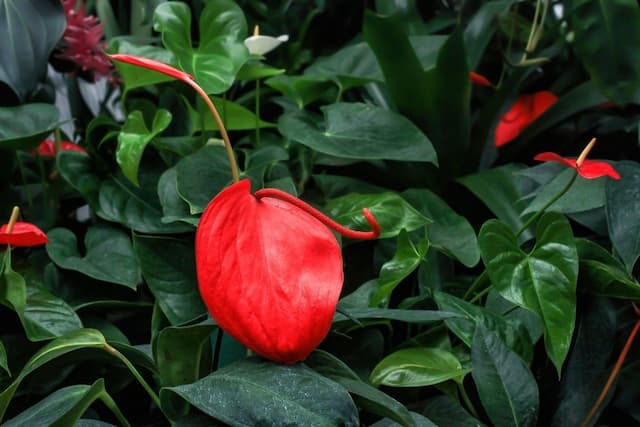Calla Lily 'Crystal Blush' Zantedeschia 'Crystal Blush'

ABOUT
Zantedeschia 'Crystal Blush', commonly known as Calla Lily, is an ornamental plant celebrated for its elegant and sophisticated appearance. It features a distinctive flower shape with a gracefully arching spathe that resembles a flared trumpet. The flowers of 'Crystal Blush' are particularly noted for their subtle coloration, starting off as a pure white and often developing a hint of pale pink as they mature, reminiscent of a blush on the petals. At the center of the spathe, there is a finger-like spadix which stands as a focal point. The foliage of the Calla Lily is also attractive, with broad, lance-shaped leaves that often have a glossy texture and can sometimes showcase light spotting. The overall impression of the Zantedeschia 'Crystal Blush' is one of refined beauty, with its delicate colors and classic form making it a favorite for both gardens and as a cut flower for arrangements.
About this plant
 Names
NamesFamily
Araceae
Synonyms
Calla Lily, Arum Lily, Crystal Blush Calla Lily
Common names
Zantedeschia 'Crystal Blush'
 Toxicity
ToxicityTo humans
Calla Lily 'Crystal Blush' contains calcium oxalate crystals that are toxic to humans. If ingested, any part of the plant can cause symptoms such as a burning sensation in the mouth and throat, swelling of the lips, tongue, and throat, difficulty swallowing, and possible vomiting and diarrhea. In severe cases, it can cause difficulty breathing due to throat swelling, which requires immediate medical attention.
To pets
Calla Lily 'Crystal Blush' is toxic to pets due to the presence of calcium oxalate crystals. Ingesting parts of the plant can cause symptoms such as oral irritation, drooling, vomiting, difficulty swallowing, and decreased appetite in animals. Severe reactions could include swelling of the mouth and throat, possibly leading to breathing difficulties, which would necessitate prompt veterinary care.
 Characteristics
CharacteristicsLife cycle
Perennials
Foliage type
Evergreen
Color of leaves
Green
Flower color
White
Height
1-2 feet (30-60 cm)
Spread
1-2 feet (30-60 cm)
Plant type
Herb
Hardiness zones
9
Native area
South Africa
Benefits
 General Benefits
General Benefits- Easy to Grow: Zantedeschia 'Crystal Blush', commonly known as Calla Lily, is relatively easy to cultivate and maintain in a variety of garden settings.
- Attractive Flowers: The plant is renowned for its beautiful, trumpet-shaped white flowers that blush pink, which add a touch of elegance to any garden or bouquet.
- Long Blooming Season: Calla Lilies usually have a long flowering period that extends from late spring into the summer, providing prolonged visual interest.
- Container Gardening: They are suitable for container gardening, allowing those with limited space to enjoy their beauty on patios or balconies.
- Versatile Landscape Use: Can be used in beds and borders, waterside plantings or as a focal point in the garden due to their striking appearance.
- Attracts Wildlife: The blooms can attract beneficial insects like butterflies, adding another layer of interaction with wildlife to the garden space.
- Cut Flower Use: The flowers are excellent for cutting and creating elegant and long-lasting flower arrangements.
 Medical Properties
Medical PropertiesThis plant is not used for medical purposes.
 Air-purifying Qualities
Air-purifying QualitiesThis plant is not specifically known for air purifying qualities.
 Other Uses
Other Uses- Photography Prop: Calla Lily 'Crystal Blush' with its delicate pink hue provides a stunning backdrop or subject for professional photographers, especially for wedding and spring-themed photoshoots.
- Art Inspiration: Artists often use the elegant shape and soft color of Calla Lily 'Crystal Blush' as a muse for paintings, drawings, and sculpture.
- Edible Garnish: Although rarely considered and requiring careful preparation due to potentially irritating sap, the flowers can be used as a unique, ornamental garnish for upscale culinary dishes.
- Textile Patterns: The striking appearance of Calla Lily 'Crystal Blush' is replicated in textile design, lending a floral elegance to fabrics used in fashion and home decor.
- Eco-friendly Confetti: Dried petals of the Calla Lily 'Crystal Blush' can be used as a biodegradable confetti option for celebrations, reducing environmental impact.
- Crafts and Scrapbooking: Pressed flowers of the Calla Lily 'Crystal Blush' are perfect for craft projects and adorning scrapbook pages with a touch of natural beauty.
- Personalized Stationery: The distinct look of Calla Lily 'Crystal Blush' is often incorporated into bespoke stationery designs for weddings and other formal events.
- Candle Embeds: The petals of Calla Lily 'Crystal Blush' can be incorporated into clear candles to create visually stunning pieces that capture the flower's essence.
- Bookmarks: Laminated Calla Lily 'Crystal Blush' flowers make unique and durable bookmarks for book enthusiasts looking for a natural marker.
- Feng Shui: Calla Lily 'Crystal Blush' is placed within homes to foster happiness and to serve as a symbol of new beginnings, making it a popular choice in Feng Shui practice.
Interesting Facts
 Feng Shui
Feng ShuiThe Calla Lily is not used in Feng Shui practice.
 Zodiac Sign Compitability
Zodiac Sign CompitabilityThe Calla Lily is not used in astrology practice.
 Plant Symbolism
Plant Symbolism- Purity and Innocence - 'Crystal Blush', commonly known as Calla Lily, often symbolizes purity and innocence due to its elegant and pristine appearance.
- Beauty - The refined beauty of the Calla Lily, especially with its delicate white hue tinged with blush, makes it a symbol of magnificent and understated beauty.
- Overcoming Challenges - The Calla Lily blooms from a bulbous root amidst marshy conditions, symbolizing triumph over hardships and the ability to thrive despite challenges.
- Rebirth and Renewal - With its trumpet-shape and broad foliage, the Calla Lily represents rebirth and the heralding of spring, echoing renewal and new beginnings.
- Transcendence - The lofty stature and graceful lines of the Calla Lily can symbolize a transcendence above the mundane, representing an aspirational or spiritual journey.
 Water
WaterThe Calla Lily should be watered thoroughly once the top inch of soil feels dry to the touch, typically every week. Provide enough water each time so that it runs through the drainage holes at the bottom of the pot, indicating the soil is fully moistened. However, avoid letting the plant sit in standing water as this can lead to root rot. During the growing season, you may need to water more frequently, but always check the soil moisture before adding more water. In winter, reduce watering to every other week or when the soil is dry several inches down, as plant growth slows and less water is needed.
 Light
LightCalla Lilies flourish in bright, indirect light but can tolerate some direct morning sunlight. A spot near an east or southeast-facing window is ideal, providing a balance of light without the harsh afternoon sun. Avoid placing them in full shade or overly dark areas, as this will hinder their growth and reduce flowering.
 Temperature
TemperatureCalla Lilies prefer temperatures between 60 and 75 degrees Fahrenheit during the day and not below 50 degrees Fahrenheit at night. They are sensitive to extreme temperatures and should be kept away from drafts and heating or cooling vents. These plants can survive temporarily in temperatures as low as 40 degrees Fahrenheit but frost or prolonged exposure to cold will damage them.
 Pruning
PruningPruning Calla Lilies is mainly done to remove spent flowers and yellowing leaves to maintain the plant's appearance and encourage more blooms. Deadheading, or cutting off the faded blooms, should be done as soon as the flowers start to wilt. Trimming back yellow or dead leaves can be done at any time and helps direct energy back into healthier parts of the plant. The best time for a more thorough pruning is after the plant has finished blooming and is going dormant.
 Cleaning
CleaningAs needed
 Soil
SoilThe Calla Lily 'Crystal Blush' prefers a well-draining soil mix with a slight acidic to neutral pH, roughly between 6.0 and 7.0. A mix of two-thirds loam and one-third peat or sand is ideal to ensure adequate drainage yet retain sufficient moisture.
 Repotting
RepottingCalla Lilies, like 'Crystal Blush', should be repotted every two years to refresh soil and provide space for growing. Best done after the dormancy period in late winter or early spring.
 Humidity & Misting
Humidity & MistingCalla Lily 'Crystal Blush' thrives in moderate to high humidity levels around 60-70%. Avoid placing in overly dry environments or use a humidifier if necessary.
 Suitable locations
Suitable locationsIndoor
Place in bright, indirect light. Keep in warm location.
Outdoor
Plant in partial shade, sheltered from strong wind.
Hardiness zone
8-10 USDA
 Life cycle
Life cycleThe Calla Lily 'Crystal Blush' begins its life cycle with the germination of a rhizome (a clump of roots), which sprouts into a seedling under warm and moist conditions. As it grows, the plant develops lush, green foliage and a strong stem, which eventually gives rise to a single, elegant bloom, with the 'Crystal Blush' variety featuring a white spathe with a pink blush. After flowering, which occurs in late spring through summer, pollination may take place, leading to the production of berries containing seeds. Once the flowering and potential seed production are complete, the plant enters a period of dormancy, usually in late autumn or when temperatures drop. During dormancy, the foliage dies back, and the plant conserves energy within the rhizome. With the return of warmer weather and increased daylight, the cycle begins anew as the plant emerges from dormancy, sprouts new growth, and prepares for another flowering season.
 Propogation
PropogationPropogation time
Spring to Summer
The most popular method of propagation for the Calla Lily 'Crystal Blush' is by dividing its rhizomes. This process is typically undertaken in late winter or early spring before the growing season commences. To propagate, the plant is carefully lifted from the soil and the rhizome is divided by cutting with a sharp, clean knife ensuring each section has at least one growth eye or shoot. The cuts should be treated with a fungicide to prevent disease. The sections are then replanted in well-draining soil to a depth of about 4 inches (approximately 10 centimeters), spaced around 12 to 18 inches apart (approximately 30 to 45 centimeters). It's important to water them in well and maintain soil moisture without waterlogging during establishment.









